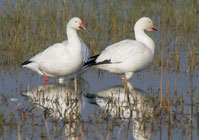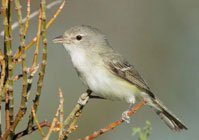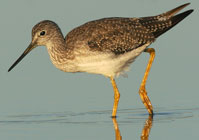Accomplishments
The CVJV partnership has earned an impressive record of accomplishment since its inception in 1988, and is making great progress towards meeting the objectives identified in its 2020 Implementation Plan.

 Bell’s Vireo
Bell’s VireoBy Jill Shirley, Outreach Coordinator
Central Valley Joint Venture

In today’s Central Valley Joint Venture (CVJV), collaboration between hunting and non-hunting groups is taken for granted. CVJV partners, indeed most conservation organizations, no longer question the alliances that have brought so many positive results for birds and habitat. But those relationships did not always exist. Twenty-five years ago the CVJV helped create a model of collaboration for hunting and non-hunting conservation organizations to work together toward the common goal of protecting waterfowl. Their efforts also provided the catalyst for state and federal resource agencies to cooperate far more effectively on bird conservation issues. The innovative, bipartisan spirit of the early Joint Venture years led to remarkable success in achieving the goals described in the Central Valley Habitat Joint Venture 1990 Implementation Plan (1990 Plan) and encouraged more funding from state, federal and private sources for important acquisition and restoration projects.
The National Audubon Society, one of the original members of the Central Valley Habitat Joint Venture, played an instrumental role in leading the partners of the Joint Venture towards common ground. Glenn Olson was Audubon’s Western Regional Vice President and a signatory to the 1990 Plan. He remembers the time well. “State and Federal agencies had questions about who was ultimately responsible for on-the-ground conservation of the state’s wildlife, including migratory birds and endangered species. The Audubon office was located halfway between the state agencies in downtown Sacramento and federal agencies east of the city. It provided a neutral ground for hosting meetings. Over time, the individuals at the table developed a genuine respect for each other, which was reflected in an early and impressive record of success.” For Olson and Audubon there were multiple pay-offs. Relationships formed in those early years would prove critical to Audubon’s wetlands conservation program. Olson launched a California Wetlands and Waterfowl Stewardship Committee that accelerated progress towards the goals of the 1990 Plan. Actions included:
Olson says that success on the ground was not the only benefit of collaboration. “Partners working together could make a political show of force. We produced tangible results that no group could get working alone.”
It took time, persistence and results to convince the members of Audubon that collaborating with hunters was a good thing. The same was true of Defenders of Wildlife. As an organization, Defenders of Wildlife was opposed to hunting. According to Olson, Defender’s California Representative, Richard Spotts, helped transform their attitude. His knowledge of water law was critical and helped to build trust within the group. “Having Richard’s legal expertise on water law combined with California Waterfowl Association lobbyist Dan Chapin’s political acumen, led to the signing of the 1992 Central Valley Project Improvement Act into law. It was a big success, promising firm water supplies for wetlands within the Grassland Water District and to all state and federal wildlife refuges in the Valley,” Olson said. Like the first Joint Venture Coordinator Gary Kramer, Olson believes that trust between the original Management Board members was a critical factor in building the bonds that provided a solid foundation for future accomplishments. That foundation and spirit continues 25 years later, in today’s CVJV.
Olson served with all three CVJV coordinators – Gary Kramer, Dave Paullin and Bob Shaffer – and has nothing but praise for each of them. He gives the Joint Venture credit for arresting the loss of wetlands in the Central Valley, beginning the effort to restore and add to the base – hundreds of thousands of acres to date – and launching the partnership with the rice industry in the Sacramento Valley.
In 2010, Olson was appointed by Secretary of the Interior Ken Salazar to the North American Wetlands Conservation Act Council (NAWCA). Since its passage in 1989 by Congress, more than $1 billion in Federal appropriations has been matched by over $3 billion in non-federal funds leading to more than 25 million acres of wetlands restored and conserved for migratory birds. Olson testified last year before the House Natural Resources Committee seeking to reauthorize NAWCA by calling it “the single most effective bird conservation initiative in North America over the past 25 years.”
Like Glenn Olson, many of the founding members of the Central Valley Joint Venture continue to work on behalf of the national joint venture program and migratory birds, and have a major impact on conservation efforts both in the Central Valley and across North America. The conservation movement of today can thank those original members for bravely challenging the status quo, overcoming their differences, and focusing on their common mission of restoring waterfowl populations, and the habitat needed to sustain them. In so doing, they made it easier for other conservation partnerships to form, with tremendous benefits for birds, wildlife and habitat.
The CVJV partnership has earned an impressive record of accomplishment since its inception in 1988, and is making great progress towards meeting the objectives identified in its 2020 Implementation Plan.

Follow these links to learn about some of the important bird conservation work happening in California's Central Valley.
